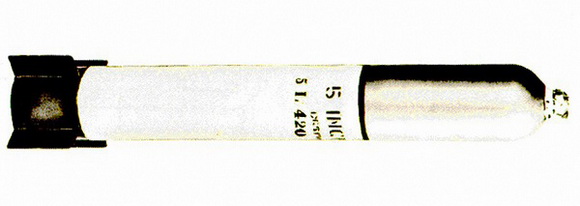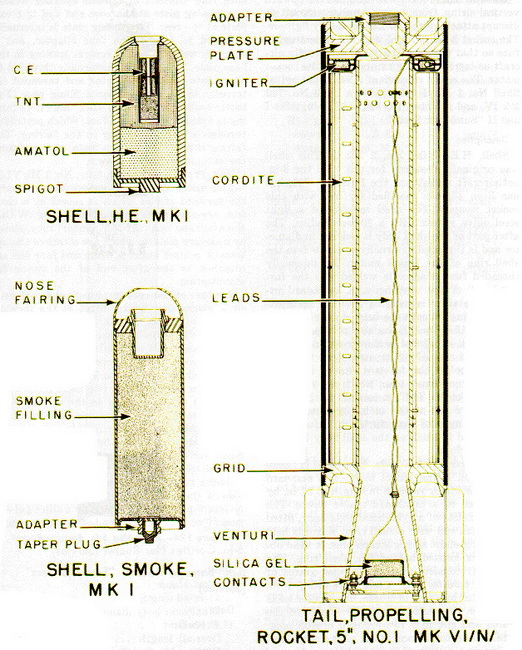|
|
| BRITISH EXPLOSIVE ORDNANCE |
| Part 3 - Chapter 2 |
| High-Explosive Rockets |
|
5-in. Barrage Rocket, "Sea Mattress" (Service) |
| Data |
| H.E. Shell | H.E. Mk I/L | |
|
Over-all length |
11.6 in. | |
|
Diameter |
5.0 in. | |
|
Total weight |
29 lb. | |
|
Fuzing |
No. 722 Mk III | |
|
Filling |
Amatol (60/40 or 50/50) or Amatol and TNT |
|
| Chemical Shells: | Smoke Mk I/L | Incendiary Mk I/L |
|
Over-all length |
19.7 in. |
19.7 in. |
|
Diameter |
5.0 in. | 5.0 in. |
|
Total weight |
29 lb. | 25 lb. |
|
Fuzing |
No. 721 Mks I - III | No. 721 Mks I - III |
|
Filling |
C.S.A., F.M. or W.P. |
Perspex Benzole Gel |
| Rocket Motor | ||
|
Over-all length |
25.75 in. | |
|
Diameter |
5.0 in. | |
|
Total weight |
29.0 lb. | |
|
Propellant |
11 grains of tubular cordite | |
|
Propellant weight |
5.5 lb. (approx.) | |
|
Width of fins |
1.9 in. | |
|
Burning time at 60° F. |
0.35 sec. |
|
|
General: These rockets are intended primarily for beach barrage from landing craft. The incendiary bomb is employed only for ranging purposes, providing a visual indication of the attainment of the proper range. A change-over is the made to H.E., or smoke. The complete round consists of H.E. Bomb, and Propelling Tail Rocket, 5-in., No. 1 Mk VI/N; Incendiary Bomb, and Propelling Tail, Rocket, 5-in., No. 1 Mk VI/N, or Smoke Bomb and Propelling Tail, U. 5-in., Mk III/N. |
|
Description |
|
Bomb, H.E., 29-lb., 5-in., Mk I/L – This shell consists of a thin-walled steel forging, closed at the after end by an externally threaded base plate. The base plate carries a threaded spigot which screws into the shell adapter of the rocket motor. Set into the explosive filling at the nose end of the shell is an exploder container with two perforated and solid C.E. booster pellet. The shell may be alternatively filled with Amatol or an upper layer of TNT and a lower layer of Amatol. If the former filling is employed a TNT surround is located around the exploder container. The shell is painted buff over-all. |
|
Bombs, Smoke, and Incendiary, 5-in., Mk I/L – These shells are of identical construc-tion, differing only in the nature of the filling. The shell body consists of a metal cylinder welded to a closing plate at the nose end and to a tail plate at the rear. The closing plate is internally threaded to receive the fuze adapter, and a spigot is welded into the central opening in the base plate. This spigot is externally threaded to screw into the rocket motor and threaded internally to receive a tapered filling plug. For better ballistic qualities, a shell steel nose fairing is fitted over the nose fuze, which protrudes through a central opening in the fairing. The fairing is held in place by a metal circlip around the outside of the fuze body. |
|
Tail, Propelling, Rocket, 5-in., No. 1 Mk VI/N – This motor consists of a cylindrical steel body, the forward end of which is closed by a cast-iron pressure plate and a transit plug. Within the after end is a cast-iron venturi tube, closed by a closure plate to which are attached the automatic contact leads. A drum and four fins are attached to the after end of the motor for stabilization. |
|
Ignition of the cordite propellant is achieved by a magnesium igniter fitted at the for-ward end of the cordite grains. The igniter is fired by an electric squib. Fuze, Electric, No. F 53 Mk I, whose leads pass to two sockets fitted to, but insulated from, the venturi closing plate. An automatic contact disc is fitted to the outer side of the closure plate, two leads from which are fitted to two sockets in the closure plate. The automatic con-tact disc connects one of the ingiter leads to the "ground", in this case the motor body. The central brass disc of the automatic contact disc makes contact with an insulated spring finger on the projector. |
|
These rocket motors must not be fired out-side of the temperature range of 0° to 120° F. Moisture-proofing is effected by a silica gel capsule fitted into the after end of the venturi tube. |
 |
| Figure 194 – Assembled 5-in. Barrage Rocket |
 |
| Figure 195 – 5-in. Barrage Rocket Components |